Publications

Publications may be purchased in person at the Balmain Watch House when Balmain Association volunteers are there – Saturdays between 11:30am and 3:00pm and Tuesdays between 11:00am and 1:00pm. Holiday periods excepted.
Please click Google Search – Balmain Watch House hours to check.
Publications may also be ordered by email for delivery by Australia post.
Please download the Publication Order Form. The form provides details of pricing, postage and handling costs and payment methods.

$20.00
+$4.50 postage
New Publication
Balmain Hospital – The History of
Featuring Anecdotes and Art Work by Jan Wood
Jan Wood
The History of Balmain Hospital touches on the social, political, technological and medical changes since 1885 when a new awareness of the importance of hygiene and sanitation became aligned with technology.
Balmain Hospital is a microcosm of what was happening in the wider world from hygiene, the moving away from paraffin and gas lighting to the advent of electricity in 1910, the installation of the telephone and the provision of the latest technology in X-Ray machines in the early 20th Century.
This brief history touches on world events, the Bubonic Plague in 1900, WW1, the Spanish Flu epidemic of 1918, the Great Depression, WW2 and AIDS.
So Many changes over the lifespan of Balmain Hospital, but one thing stays constant, the dedication of our healthcare workers, particularly our nurses.
Soft Cover, 124 pages, 2023
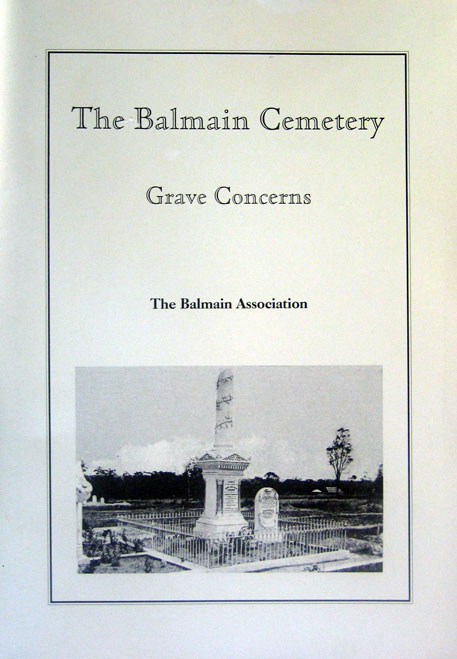
$10.00
+$7.50 postage
Balmain Cemetery, Grave Concerns
Bonnie Davidson and Kathleen Hamey
The importance of the Balmain Cemetery has been little appreciated in the past except by the family historian, who, when obtaining the death certificate of an ancestor, would find under place of internment – the Balmain Cemetery.
Where was this cemetery that accepted 10,608 burials from 1868 until its closure in 1912.
It is with regret the historian is told the sorry tale of neglect and vandalism of the headstones, when the Cemetery area in Norton Street Leichhardt became Pioneer Memorial Park in 1941.
Read about the efforts of historian Percy Gledhill who rescued and relocated sixteen memorials in the 1940s, find out where many of the headstones went and why the Balmain Cemetery is in Leichhardt.
Soft Cover, 51 Pages, 1999

$4.00
+$3.45 postage
Balmain History Trail
Sixty three commemorative plaques were installed on buildings of note in Balmain and Birchgrove as a Bicentennial Project by members of the Balmain Association and the Rotary Club of Balmain.
The booklet provides a details of each plaque and a map tracing the location of each of the plaques starting from Darling Street ferry wharf in East Balmain and winding through Balmain and Birchgrove to Mort Bay Park.
Soft Cover, 10 Pages, 1992

$20.00
+$4.50 postage
Balmain Hospital – The History of
Featuring Anecdotes and Art Work by Jan Wood
Jan Wood
The History of Balmain Hospital touches on the social, political, technological and medical changes since 1885 when a new awareness of the importance of hygiene and sanitation became aligned with technology.
Balmain Hospital is a microcosm of what was happening in the wider world from hygiene, the moving away from paraffin and gas lighting to the advent of electricity in 1910, the installation of the telephone and the provision of the latest technology in X-Ray machines in the early 20th Century.
This brief history touches on world events, the Bubonic Plague in 1900, WW1, the Spanish Flu epidemic of 1918, the Great Depression, WW2 and AIDS.
So Many changes over the lifespan of Balmain Hospital, but one thing stays constant, the dedication of our healthcare workers, particularly our nurses.
Soft Cover, 124 pages, 2023

$55.00
+$12.95 postage
Balmain Peninsula – Industrial Vandalism?
This book contains a collection of heavy and light industries that operated on the Balmain Peninsula (Balmain, Birchgrove and Rozelle) during two phases of its industrialisation (Phase 1: 1850s-1900; Phase 2: 1901- 1950s). It traces the European damage to the First Nations environment, the fallout from the heavy industries, the utilitarian products from the 20th century and ends with Balmain’s de-industrialisation.
Discover, images of these long forgotten industries, the rise of the Labor Party and the effect they had on the development of a unique community that was valued and looked after its workers. A pull out map allows the reader to discover just where these 68 industries existed.
Soft Cover 116 pages 2023

$25.00
+$12.95 postage
Balmain Peninsula Transport History
Duncan MacAuslan
Balmain Peninsula Transport History provides a fascinating insight into the ferries, trams, railways, horse and motor buses of a bygone era. From the early days watermen rowed residents from Millers Point to wharves at the east end of the peninsula. As the population grew the watermen formed a ferry company under the control of the Perdriau family which in the 1880s became the Balmain Steam Ferry Company providing services to wharves on both the north and south sides of the peninsula. Duncan’s book takes us on a journey from the days of those very early ferries and horse drawn buses, through the era of trams to the present day.
Balmain Peninsula Transport History is published by the Balmain Association and sponsored by Cobden and Hayson.
Soft Cover, 102 Pages, 2016

$49.95
+$12.95 postage
Balmain Peninsular – Death by Demolition
Helen Carter with Preface by Ray Stevens
This remarkable 116 page book, now with a pull out map, traces the history of demolished houses in the Balmain area (Balmain, Birchgrove and Rozelle) from its earliest house built c 1815 to an inter-war bungalow recently demolished in November 2021.
The 50 specific examples and 5 buildings, accompanied by a small history of who lived in these houses until their demise, vary from a marine villa to the humble iron house.
It opens with the premise that the demolition of the houses was a crime although it soon becomes clear that there were various reasons for their destruction. What makes this publication interesting is the inclusion of photographs, advertisements and plans that give us evidence of the what type of structure existed, their internal details and who were their owners or occupants. A snap shot of life in a unique and early Sydney suburb in the 19th and 20th century.
The first edition of Death by Demolition did not include a pull out location map. To download the map click here
Soft cover, 116 pages – Third edition July 2023

$8.00
+$3.00 postage
Balmain Places 1
Morts Dock
Peter Reynolds
Revised edition Duncan MacAuslan 2022
Morts Dock – Origins and Changes
Mort Bay was called Waterview Bay. At the head of the bay was the mouth of a small stream which ran down from the Balmain Hill through the valley of Strathean. On its way the stream collected in pools which came to be known as Curtis’ waterholes – an important source of fresh water in the days before corrugated iron tanks and piped water supply.
This booklet traces the history of the area and Morts Dock from this time through its various owners and operations to its closing in the 1960s.
Soft Cover, 12 pages, second edition 2022

$8.00
+$3.00 postage
Balmain Places 2
Balmain Coal Mine
Peter Reynolds
Revised edition Balmain Association 2022
The Coal Mine – Under the Harbour
Sydney Harbour was a bustling port in the second half of the 19th century with Balmain a centre of maritime industry. Many waterfront activities, for example Morts Dock, repaired and built ships which relied on coal as a source of power.
In the 1890s Balmain was declining as a pleasant place to live. Another heavy industry would accelerate its decline – the coal mine.
Below Sydney harbour, the Bulli coal seam swept along the coast between Newcastle and Wollongong about 950m below sea level. To tap this seam within Sydney harbour would eliminate transport cost, provide a local supply of coal, and allow ships to be loaded for export.
This booklet provides details of the mine shafts, their construction and operation and the impact on the community through to the sealing of the shafts in 1945.
Soft Cover, 16 pages, second edition 2022

$8.00
+$3.00 postage
Balmain Places 3
Gladstone Park
Peter Reynolds
Revised edition Duncan MacAuslan 2022
Gladstone Park – The Pigeon Ground
Beneath Gladstone Park lies the old Balmain reservoir. Before the Park was thought of, the place was known as the Pigeon Ground. In earlier days pigeon shooting took place on land opposite the Town Hall. Later the principal pigeon matches were “shot off” on land owned by the a’Beckett family since 1853 – now known as Gladstone park.
This booklet details the history of the development of the park, its use as an underground water reservoir, and the resident action to maintain and improve facilities such as the bandstand, bowling club and school.
Soft Cover, 12 pages, second edition 2022

$8.00
+$3.00 postage
Balmain Places 4
The Watch House
Revised edition Duncan MacAuslan 2024
The Watch House – A history
In 1851 resident numbers in Balmain had grown to 1,397 and the settlement along Darling Street was thriving. As the population grew, the community demanded a police force and a gaol.
The Government approved funding of £450 and Edmund Blacket, the Colonial Architect, worked together with the Inspector General of Police to find a suitable site and design. In 1853, Lot 47 of the Waterview Estate was purchased for £240 from Edward Hunt. It was to become the new Balmain Watch House.
This booklet traces the history of The Watch House and the people who have lived there from construction in 1855 through to its present use as the home of the Balmain Association.
Soft Cover, 16 pages, second edition 2024

$25.00
+$12.95 postage
Balmain to Glebe
By Joan Lawrence and Catherine Wayne
A Pictorial History.
The once Leichhardt Municipality is composed of Balmain, Birchgrove, Rozelle, Lilyfield, Leichhardt, Annadale and Glebe but each area has its own unique and interesting history.
Once virgin bush and tribal lands to the aborigines the land was parcelled out in government grants soon after European settlement at Sydney Cove.
This book, richly illustrated, traces the development of the municipality from then to the present day.
Soft Cover, 139 Pages, 2009 third edition

Marked down $2.00
+$4.80 postage
Balmain: 1800-1882 The Gilchrist Settlement – A Basic Search Plan
Balmain: 1800-1882
The Gilchrist Settlement – A Basic Search Plan
Peter L Reynolds
This Basic Search Plan has been compiled with the sole aim of allowing each separate allotment of present-day Balmain land to be seen in the context of its origin, its legal title and its historical development.
While dated and with much more data available on line, this booklet still provides detailed guidance – particularly in the area of Old System Titles.
Many of the searches referred to in this book can now be carried out at Land Registry Services on line.
Additionally, Stephen South’s web site, Land Research NSW, provides a wealth of information.
Marked down owing to deterioration of staples.
Soft cover, 20 pages, 1978

$25.00
+$7.50 postage
Broughton Hall : Brought To Life
Roslyn Burge for Friends of Callan Park
Broughton Hall is the name given to the two-storied Georgian House painted white and built in 1842 on a three acre corner of Wharf Road and Church Street Liyfield. By 1878 the Keep family, who owned Broughton Hall, purchased the rest of the property with another fine house known as Kalouan.
Broughton Hall gave its name to the psychiatric clinic established after WW1 and later the day hospital.
This remarkable publication, two decades in the making, provides a detailed history of Broughton Hall from 1840 to the present. A fascinating read with many historic pictures and documents.
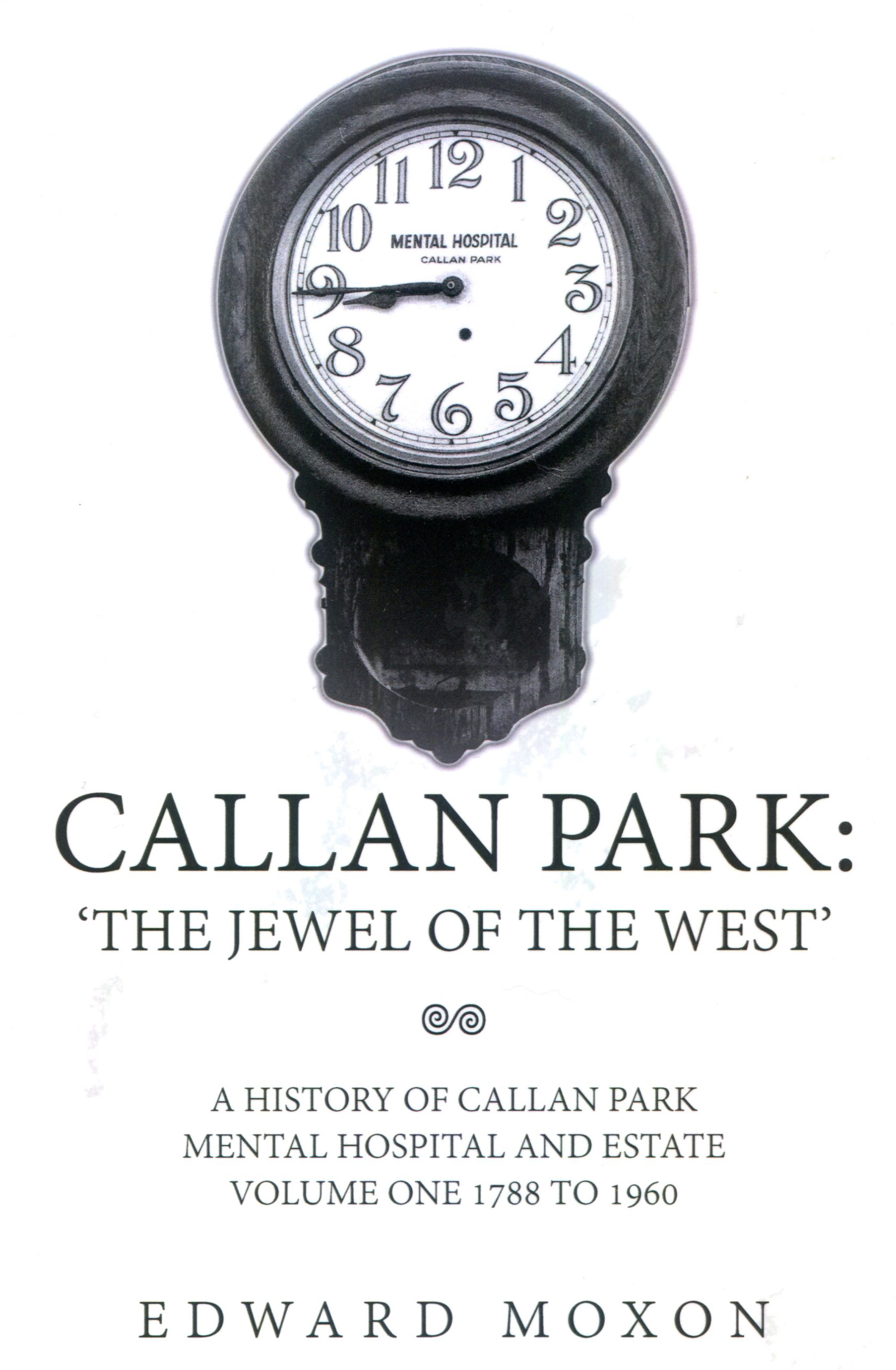
$30.00
+$12.95 postage
Callan Park: ‘The Jewel of the West’
A history of Callan Park Mental Hospital and Estate
Volume 1 1788 to 1960
Edward Moxon
This book is a record of events that happened at Callan Park before 1960. It is a journey of discovery that uncovers facts and manoeuvring not published before.
Many internal and external variables shaped the history of Callan Park, Fundamentally, its staff, its patients, the government of the day, charismatic and visionary individuals, technological advances, the economy and the community surrounding the hospital were catalysts in this process.
This book provides a detailed account of the development and intrigues of Callan Park over the period supplemented by many photographs.
Soft cover, 424 pages, revised 2022
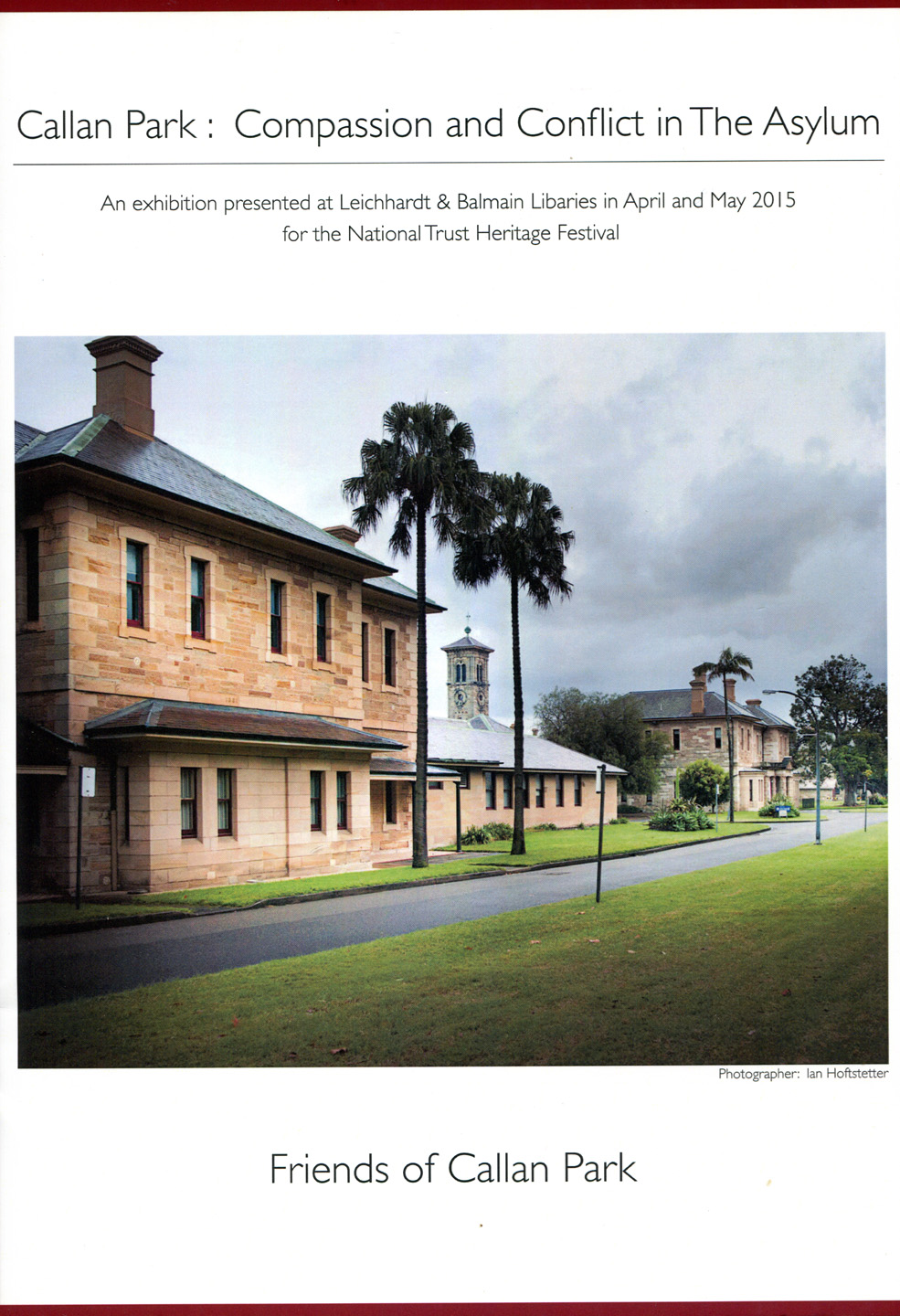
$15.00
+$7.50 postage
Callan Park: Compassion and Conflict in the Asylum
Friends of Callan Park
This book is a record of an exhibition presented at Leichhardt and Balmain Libraries in April and May 2015 for the National Trust Heritage Festival.
Thousands of people have passed through the gates of Callan Park a site where history is many layered. There are stories of horror and abuse and stories of respite and care and recovery.
The exhibition highlights the stories of patients in the asylum, staff who worked in the wards, children who grew up within the walls and the broader community who care about Callan Park.
Beautifully illustrated.
Soft Cover, 28 Pages, 2018

$10.00
+$4.50 postage
Called to the Bar
Bonnie Davidson, Kath Hamey and Debby Nicholls
150 years of Pubs in Balmain and Rozelle
The first hotel in Balmain opened in 1842 to provide refreshment for the occupants of the houses being built on the recently subdivided land, and from that time on, hotels provided a basis for the social and political life of the growing suburb.
At this time licenced hotels were open from 4am to 6pm and were required to have two sitting rooms and two sleeping rooms fit for public accommodation. In 1849 the closing hour was extended to 10pm.
This volume is an attempt to provide a pictorial history of all the hotels which have existed since the first residents moved into the area.
Soft Cover, 64 Pages, 1997

$15.00
+$7.50 postage
Douglas Grant: that Black Digger from the Scottish Mob
Tony Griffiths
This is an account of Douglas Grant’s life.
The author says
“Douglas Grant wasn’t of any special importance in factory activity; it’s just that his name cropped up quite often in newspapers in the inter-war periods – too often for just an ordinary factory worker. He wasn’t a manager or even a foreman or a leading hand, but he was evidently a man of some note, and he was an educated pure aboriginal sometimes intriguingly called “the Black Scotsman”. I decided to explore his life; he seemed an intriguing man”.
As a WW1 ex serviceman Douglas spent time at Callan Park. In 1931, working with fellow patients, he made his mark by using his professional skills to help design a war memorial based on the arch of the Sydney Harbour Bridge. The memorial was unveiled in August 1931 by the State Governor, Sir Philip Game. Douglas stood beside the Governor for press photographs.
The memorial is still in place in Callan Park
Douglas had a many and varied career – indeed an intriguing man
Soft Cover 46 pages 2015

$20.00
+$7.50 postage
Down The ‘Olive
Written and edited by Else Lackey and Monica Vardabasso
A memory of Colgate-Palmolive in Balmain, New South Wales.
The Balmain plant is where it all started for Colgate-Palmolive in Australia. In 1923 when the first soap boiling took place, Balmain was a suburb known for its industry, its shipyards and it coal mine.
This small book is not a definitive history of Colgate-Palmolive or the Sydney suburb of Balmain. It is a book of memories of some of the people who worked at Colgate-Palmolive’s first Australian factory and it reflects an important part of Australian history gone forever.
Soft Cover, 35 Pages

Sale $10.00
+$7.50 postage
Exploring Leichhardt Heritage
Compiled by Jeanette Knox on behalf of the Heritage Group of Leichhardt District
Selected walks in the municipality.
The municipality of Leichhardt is an inner city one which incorporates the suburbs of Annandale, Birchgrove, Rozelle, Leichhardt, Lilyfield and, between 1968 and 2003, Glebe.
All these areas were amongst the earliest settlements in the Sydney region and they still retain significant buildings dating back to the 19th century. The walks described in this booklet enable the visitor to observe many of them.
Soft Cover, 64 Pages, 2010
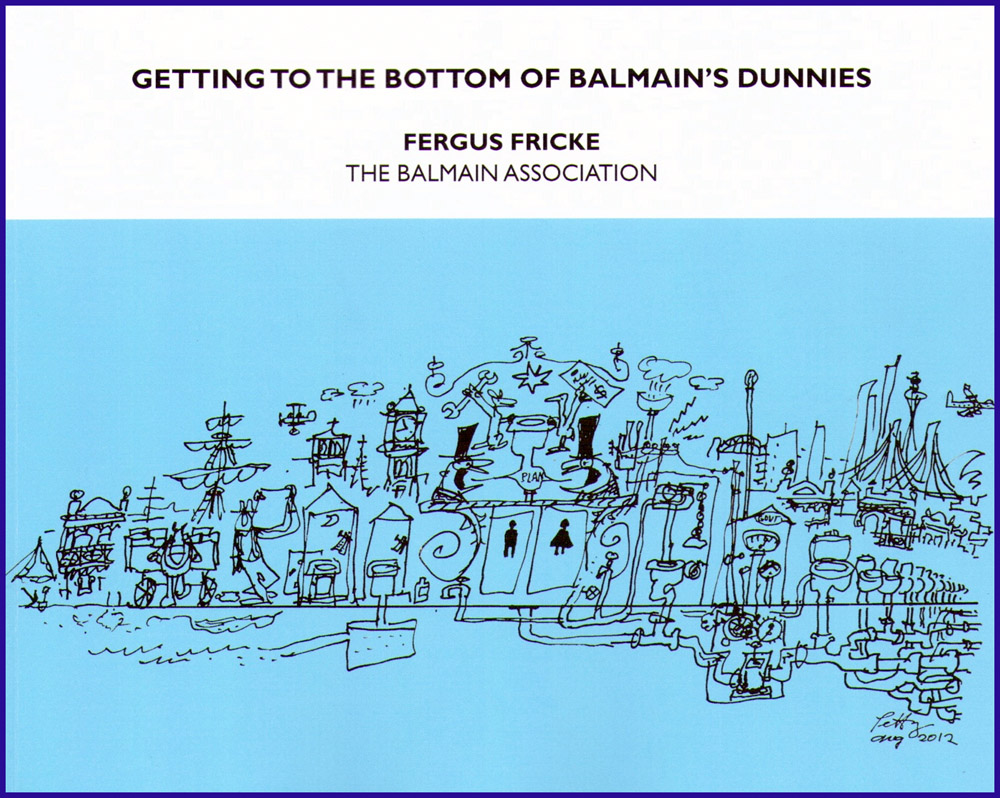
$10.00
+$7.50 postage
Getting to the Bottom of Balmain’s Dunnies
Fergus Fricke
What was life like in Balmain in the 19th century when there was no reticulated water supply and there were no sewers.
This book will never allow you go to the toilet without a passing thought for high infant mortalities, dunnies out the back or nightmen whose bread and butter was what you usually put down the toilet.
The present sanitation system that you take for granted saved Sydney from self-destruction. Learn some defecating history as well as some of the politics of water supply, sewerage and infectious diseases.
The few remaining Balmain dunnies are both an endangered species and a reminder of a critically important part of our history that Getting to the Bottom of Bamain’s Dunnies flushes out.
Soft Cover, 79 Pages, 2012

$15.00
+$7,50 postage
Gourlie’s Corner
Edited by Kath and Val Hamey
Growing up in Balmain with Wal Gourlie.
Some years ago Wal Goulie gave the Balmain Association a dozen pages of memories of his boyhood which he titled “Balmain of Old”. With Wal’s permission the material appeared in the Balmain Association’s monthly newsletter, frequently with additional information to update the article.
The resulting column “Gourlies Corner” became one of the publication’s most popular features.
This volume brings together all of the material he provided, together with some of the additional data. It also include for the first time his recollections of his school days.
“Gourlies Corner” was a shop on the corner of Grove and Cove streets Birchgrove.
Soft Cover, 56 Pages, 1992 Reprinted 2023

$20.00
+$12.95 postage
Half a Thousand Acres
Peter L. Reynolds and Paul V. Flottmann
A history of the Balmain land grant.
In this book the lives and times of the two main characters concerned with the Balmain Land Grant , Dr William Balmain and Professor John Gilchrist emerge from hitherto obscurity and become clearly defined by the authors’ painstaking research.
The real substance of the book, however, lies in the posthumous effect of the two significant legal actions made in their lifetimes; one, the recipient and transfer of “Half a Thousand Acres” and the other, the execution of their wills.
Limited copies.
Hard Cover, 147 Pages, 1976

$15.00
+$7.50 postage
Jack’s Story – Growing up in Balmain
John Thomson
John Thomson, known to his many friends as Jack, has spent all his life in Balmain. Born in 1927 Jack remembers the days of the Depression, when kind greengrocers put aside “specs”, fruit which had spots on it that they gave to hungry children. As well Jack’s childhood had it trials.
Soft Cover, 96 Pages, 2016

POA
Leichhardt Historical Journal
There are 23 volumes of the Leichhardt Historical Journal. For more information contact the Association.
Contents cover Leichhardt, Annandale, Lilyfield, Glebe, Balmain, Birchgrove and Rozelle.
Prices vary.

$10.00
+$4.80 postage
On The Pigeon Ground
Balmain Public School 1860-1965
Peter Reynolds
Balmain Public School, by virtue of the chronolgy of its founding, has a special place in New South Wales’ history – it was one of 259 National Schools opened during the operation of the National System betewen 1848 and 1866.
Developed like many schools in piecemeal fashion, the school had several names, National School (1860), Public School (1866),Superior Public School (1881), Demonstration School (1946), and Public School again (1966).
The school opened in 1860 in rented premises and then moved in 1862 to a permanent building which, when redundant in 1917, was bought by the Roman Catholic Church and is now the Father John Therry School (Eaton Street)
Soft Cover, 56 Pages, 1995

Marked down $10.00
+$7.50 postage
Open Council: A new Era in Local Government
Issy Wyner
Edited and introduction by Hall Greenland
Issy Wyner was probably the best placed person to write an account of Leichhardt Municipality’s experience with Open Council, the pioneering experiment in public participation and open government that was initiated 37 years ago. Issy was one of the architects of this new system of local government and was as an Alderman and Councillor from Balmain on Leichhardt Council for 25 years from 1959 through to 1991.
He was also a historian who kept meticulous files on the Council’s activities during those years.
This volume is an edited version of Issy’s original draft which has been placed in the local history section of Leichhardt library, along with his Council papers.
Marked down owing to minor discolouration of spine.
Published by the Balmain Association July 2008.
Soft Cover, 88 Pages, 2008

$25.00
+$7.50 postage
Streets, Lanes and Places
Yvonne Davidson and Kathleen Hamey
New revised edition Duncan MacAuslan 2017
An index to the origins of the street names of Balmain, Birchgrove and Rozelle.
What’s in a name. When it comes to streets, there is a wide variety of options. Back in the early days of Balmain, names became attached to tracks to identify them and some of those names remain.
As time passed, purchasers may give the name of the family or of members of the family to the street.
Others are identified with place names in England, Scotland or Ireland. Still others were named for government officials, battles, sportsmen, members of the Royal Family or well known citizens.
Find out the origins of your street name and of all the streets in Balmain, Birchgrove and Rozelle.
Soft Cover, 72 Pages, 2017 4th edition

$30.00
+$12.95 postage
Sydney’s hard rock story
Robert Irving, Ron Powell and Noel Irving
What is trachyte and how did it come to be the unsung hero of Sydney’s building stones?
The answer is found in this fascinating story of how a hard stone quarried in the New South Wales Southern Highlands became the city’s most important stone after sandstone.
The title provides an apt description: trachyte was Sydney’s hard rock. Sandstone with all its virtues was the premier building stone of Sydney’s early and middle years but trachyte had qualities sandstone lacked and so it perfectly complemented the ‘yellowblock’ of our heritage buildings. Sydney’s hard rock provided what sandstone, with all its beauty, could not provide.
This tough, distinctively coloured igneous stone was first quarried at Mount Gibraltar near Bowral in the 1880s and soon began appearing in the kerbs and gutters along the growing city’s streets. Soon it was adopted by builders and architects and it can still be seen overhead in the keystones of great buildings as well as underfoot, in myriad small and large scale projects throughout New South Wales and beyond. Its importance in the city is why the authors have called their tale Sydney’s Hard Rock Story.
The book is handsomely illustrated throughout and contains 245 illustrations including 25 colour photographs. It traces trachyte’s extensive uses, starting with its geology and some of the dramas of Bowral’s ‘Gib’ and its quarrymen. It continues by examining its basic, utilitarian beginnings like kerbing. After designers were awakened to its qualities they used trachyte to create some of Sydney’s finest commercial streetscapes, as well as monuments, foundation stones, commemorative plaques and paving.
A special feature of the book, showcasing many fine and surprising examples of this special stone, is the illustrated trachyte walk in central Sydney.
Soft Cover, 196 Pages, 2014

$5.00
+$3.00 postage
Walks
Walks 1 Balmain East
Original text by Peter Reynolds
New revised edition Duncan MacAuslan 2021
This booklet contains three walks around the east end of Balmain – Peacock and Simmons Points walk, Ewenton walk and Mort’s Dock walk.
Each walk contain a map annotated with points of interest with a brief description of each. The walks all begin at the Balmain Watch House, 179 Darling St.
Soft Cover, A5, 8 Pages, Fifth Edition, 2021

$5.00
+$3.00 postage
Walks
Walks 2 Birchgrove
Original text by Peter Reynolds
New revised edition Duncan MacAuslan 2021
Three walks offering pleasant parks, interesting buildings and scenic water views.
Long Nose Point Walk Take F8 ferry from Circular Quay to Long Nose Point where the walk begins. The walk ends at the terminus of the 441 bus to York St City.
Ballast Point Walk Take 441 bus from the QVB to the Birchgrove terminus. The walk ends at the corner of Rowntree St and MacQuarie Terrace. Take the 441 bus to York St City.
Elkington Park Walk Take 441 bus from the QVB City to corner of Rowntree St. and MacQuarie Terrace. The walk ends at the corner of Darling and Elliott streets, bus 443 returns to the city.
Soft Cover, A5, 6 Pages, Second Edition, 2022
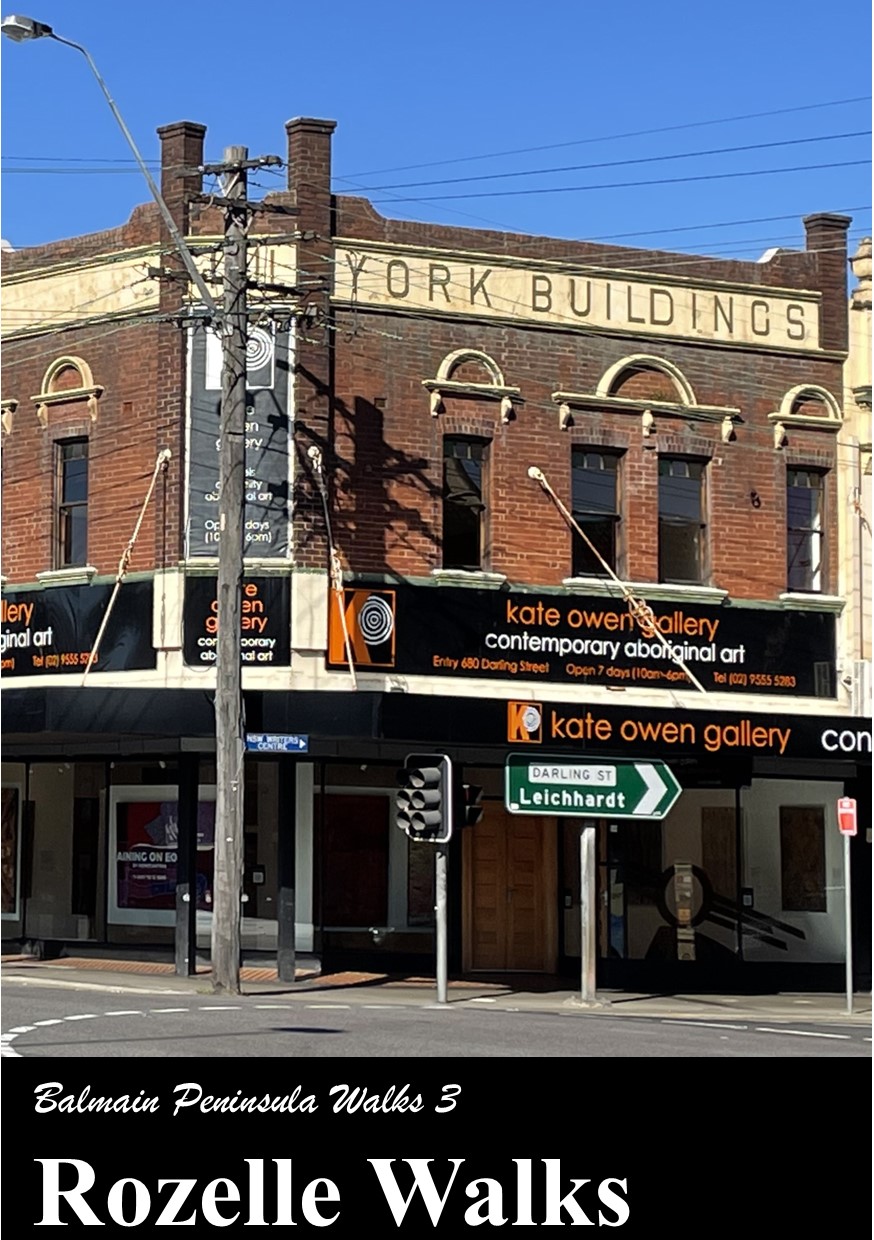
$5.00
+$3.00 postage
Walks
Walks 3 Rozelle
New edition with three new self-guided walks around Rozelle
1. South side of Victoria Road: – Merton Estate Hotel, 38 Victoria Road to Iron Cove Bridge with optional walk in Callan Park
2. North side of Victoria Road: – Rozelle Public School, 663 Darling Street to Terry and Wise Streets
3. White Bay Power Station, Victoria Road to Bald Rock Hotel, Mansfield Street
Three new walks with notes Rozelle’s interesting buildings, houses, parks, pubs and industries
Soft Cover, A5, 20 pages, Second Edition 2022

out of stock
William Balmain and John Gilchrist
The family and Property of William Balmain and John Gilchrist and their connection.


